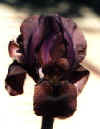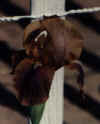|
AAAA - AABB Crosses Updated: 15 May, 2002 Returning? Jump to Photos |
|
|
In the present system, any cultivar that has more sets of aril chromosomes than non-aril is classified as an OB+, RB+, or OGB+. This page presents first-generation seedlings, from crosses between a member of the fertile family of halfbreds and a tetraploid aril. These crosses produce only OB+, RB+ and OGB+ offspring, depending on whether they have onco heritage, regelia heritage or both, and are thus relatively easy to evaluate. Click on any thumbnail to see a larger version of the photo. |
|
| This section dates to the period in which I numbered crosses when I lined out the seedlings and seedlings when they were selected to save for further evaluation and possible introduction. The numbers are therefore no indication of the number of crosses made or the number of seedlings produced by each cross. | ||
| 83-9: Mary of Magdala X Bedouin Nightfall | ||
|
83-9-1
An early selection in my quest for a wind-resistant, sun-fast red. Not introduced because a later seedling proved to be a stronger grower. |
||
|
85-5: Dunshanbe X Deborah's Song |
||
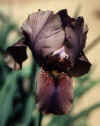
|
85-5-1 An interesting brown over near-red bitone, selected from a cross made for wind-resistant, sun-fast reds. Not introduced because, like most browns of this type, it did not increase well enough. |
|
|
85-11: Bronze Beauty X Tribe of Judah |
||
|
85-11-3 Best brown to date, with the strongest resemblance to its aril parent. Unfortunately, it was not a strong enough performer to introduce. This pattern is so rare that I have yet to find it combined with superior growth habits. |
||
| 86-9: Persian Pansy X Rose of Sharon | ||

|
Introduced as DOUG GOODNIGHT. This basic pattern is common among the offspring of PERSIAN PANSY, but the beard is normally yellow or mustard and there are usually some yellow markings on the falls. I've never had another seeding with both a near-black beard, and clean falls -- so was delighted when it proved to be one of the strongest performers of the cross. | |
|
86-11: Balalaika Music X Sunrise in Glory |
||
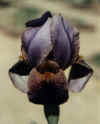
|
86-11-1
Introduced as CLASSIC ELEGANCE because the standard's violet has a silken finish and the falls' red-violet looks like plush velvet. |
|
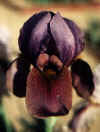
|
86-11-2 More vivid coloring than its sib that was introduced as CLASSIC ELEGANCE, but without the plush finish on the falls. This was a close call, because both had excellent flowers but they were too much alike to introduce more than one. This one was second-best in terms of performance. |
|

|
86-11-3 An unusual pastel combination that was certainly worthy of introduction, considering both the quality of the flower and the strength of the plants, as compared to the overall candidate pool for the class when I first selected it. Withheld because some later seedlings simply outperformed it. |
|
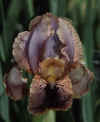
|
86-11-4 Introduced as DARINGLY DIFFERENT. |
|
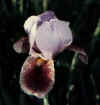
|
86-11-4 Introduced as GENUINE GEMSTONES. |
|
|
86-12: Werckmeister's Beauty X Rose of Sharon |
||

|
86-12-3 Yes, a powder-blue self with a navy signal. Distinctive among sibs that bloomed with similar pattern in shades of violet and near-black. Probably lost to a transplanting mishap -- if the remnant recovered from its abandoned seedling bed proves to be the real thing, it will simply be a keepsake. |
|
| This section covers the period in which I numbered the seedlings when they were lined out. The cross number is still no indication of the total number of crosses made of that type, but the largest seedling number does show that there were at least that many surviving seedlings. | ||
|
89-16: Ballalaika Music X Thunderstorm |
||
 |
Introduced as THINGS TO COME. The color of the falls changes markedly
when lit from different angles, illustrating the complex layered nature of
arilbred pigmentation.
More puce than brown, but the best performer I've produced in this color class. |
|
| 89-18: Werckmeister's Beauty X Child of God | ||
|
89-18-4 Exhibited the requisite quality & performance, but was just not distinctive enough to introduce. |
||
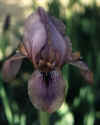 |
89-18-7
Intricate pattern, hoogiana-like form. Still under consideration for introduction. |
|
 |
89-18-15
My best approach-to-gold from this type of cross. Still under consideration for introduction. |
|
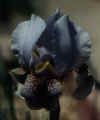 |
89-18-16
Registered as SKIES ALWAYS BLUE, because its ground color blends so perfectly into the background of the New Mexico sky and its style arms are a bright sunny-yellow. This photo clearly doesn't do it justice, so I hope to find a better one. |
|
 |
89-18-17
Exhibited the requisite quality & performance, but was just not distinctive enough to introduce. |
|
|
90-19-2: Werckmeister's Beauty X Whirlwind Tour |
||
|
90-19-2 Nice enough to be selected for further evaluation, but not as golden as some of its competitors and not as strong as some sibs in other colors. In retrospect, it should probably have been introduced anyway. |
||

|
90-19-4
Introduced as QUINCENERA. A favorite of garden visitors, in part because this complex patterned pastel background is so rare in the type. Unfortunately, though, it is camera shy.... |
|

|
90-19-8
Introduced as NONCONFORMIST |
|

|
90-19-9 | |

|
90-19-14
Introduced as FLASH OF VIOLET. |
|
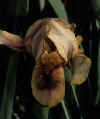
|
90-19-15
Another nice approach to gold, but it didn't pass the performance test. |
|

|
90-19-18 | |

|
90-19-19
TBR. The most distinctive feature in this complex pattern is the emerald-green tip of its beard. The upper photo was taken early in the morning when the flower had first opened and the green tints were still apparent. [To my eye, the standards aren't really that yellow-green.] The lower one was taken in the evening, of a fully expanded flower from which the top layer of pigments had faded. Its colors are also somewhat subdued because of the afternoon shade. To my eye, the true colors fall between the two. |
|
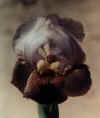
|
||
. ![]()

